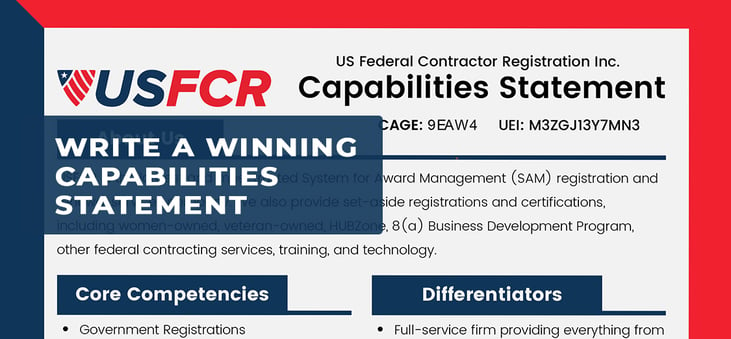
This is your guide to unlocking a wider range of opportunities and increasing your cash flow from federal contracting.
After reading this, you’ll have everything you need to write a winning capabilities statement.
Let’s go.
What This Blog Post Will Cover
- The Fundamentals Every Contractor NEEDS to Know About Capabilities Statements
- How a Well-Written Capabilities Statement Can Seriously BOOST Your Contracting Revenue
- The MOST EFFECTIVE Capabilities Statement Format for Winning a Government Contract
- Insider Tips to Make Your Capabilities Statement Stand Out ABOVE Your Competition
The Fundamentals Every Contractor NEEDS to Know About Capabilities Statements
What's a capability statement? In short, a capabilities statement is a resume for your business. It’s typically a one- to two-page brief that allows a business to highlight its specialty, expertise, and overall capabilities. It informs potential clients about what your company does and what separates you from your competitors. It's essentially your federal contracting resume. Depending on your business, it can be as simple or bold as you’d like. Of course, the more you set your business apart, the better.
Capabilities statements typically include a business’s:
- Core Competencies
- Past Performance
- Differentiators
- Corporate Data
We’ll dive into greater detail for each part later in this guide. Think of a capabilities statement as one of the best marketing tools you can utilize to get your business noticed by government buyers and prime contractors. It’s like having an elevator pitch that you can hand out at a moment’s notice.
How a Well-Written Capabilities Statement Can Seriously BOOST Your Contracting Revenue
No matter the size of your business, you should have a capabilities statement. It’s essential if you’re hoping to work with the government as an approved vendor. Government agencies often require businesses to submit a capabilities statement with their bids. Additionally, prime contractors may require subcontractors to submit capabilities statements to narrow down their choices.
Like any professional with a resume detailing their achievements, experience, and skills, each business should have the equivalent.
A capabilities statement can be especially useful in a networking environment as it saves you from cramming every point into one conversation.
It can also be a great piece to add to your website as an available download for potential government buyers and prime contractors to learn more about your business.
A capabilities statement can be as creative as you’d like for it to be, and you can tailor it to any audience.
Depending on your current objective, you should create more than one for your business. You may want to highlight certain performance data on one capabilities statement versus something else on another, depending on who your audience is.
You don’t want to appear to be a jack of all trades and a master of none. Your audience wants to know your business is real, authentic, reliable, and trustworthy. Creating an engaging and informative capabilities statement can showcase your business's greatest assets.
The outcomes of a capabilities statement are enormous. You’ll be seen as a trustworthy and reliable vendor who can lead to an irresistible offer to work with the government. The large value is to use this statement to make your business look specialized.
The MOST EFFECTIVE Capabilities Statement Format for Winning Contracts
Even the best company can come off as unprofessional or amateur with a poorly formatted capabilities statement. This is why formatting is important when creating a winning capabilities statement for your business.
Your capabilities statement should be clear, concise, and easy to read. It should be a searchable document available as a downloadable PDF that can easily be attached to emails.
It’s recommended that capability statements are created in Word or Publisher. If you have an established company logo, you should include that and any other professional photos you deem appropriate. The color scheme should coordinate with your company logo as well. Your marketing materials should always be consistent with your company’s branding.
Remember that even the tiniest details can be extremely important. This includes:
- Fonts
- Use of Bullet Points
- Word Choice
You may even want to consider hiring a graphic designer and/or professional writer to ensure that your capabilities statement is error-free and pops!
Ideally, your capabilities statement will be a living document, changing depending on the targeted agency.
Remember, each agency has its mission and focus. You’ll want to speak directly to those points using your capability statement. Don’t think of this as a one-size-fits-all document. You can tailor it as necessary, depending on your audience.

Quick! Jot These Down.
Ask yourself the following questions before creating your government capabilities statement:
- Why am I in business?
- Why should the government award me a contract?
- How can I create a stand-out resume?
- What are the unique properties that make my company unique?
- What other information does the government need to do business with me?
Knowing the answers to these questions in advance will help you streamline your capabilities statement and make sure you hit all of the most important key points. There are four main parts to a successful capabilities statement that all companies should focus on. These include:
- About Us/Company Overview
- Core Competencies
- Past Performance
- Differentiators
- Corporate Data
- Facilities or locations
- Company data
- Contact information
- Relevant codes: UEI, CAGE, NAICS Code
Check Out This Example of a Capabilities Statement:
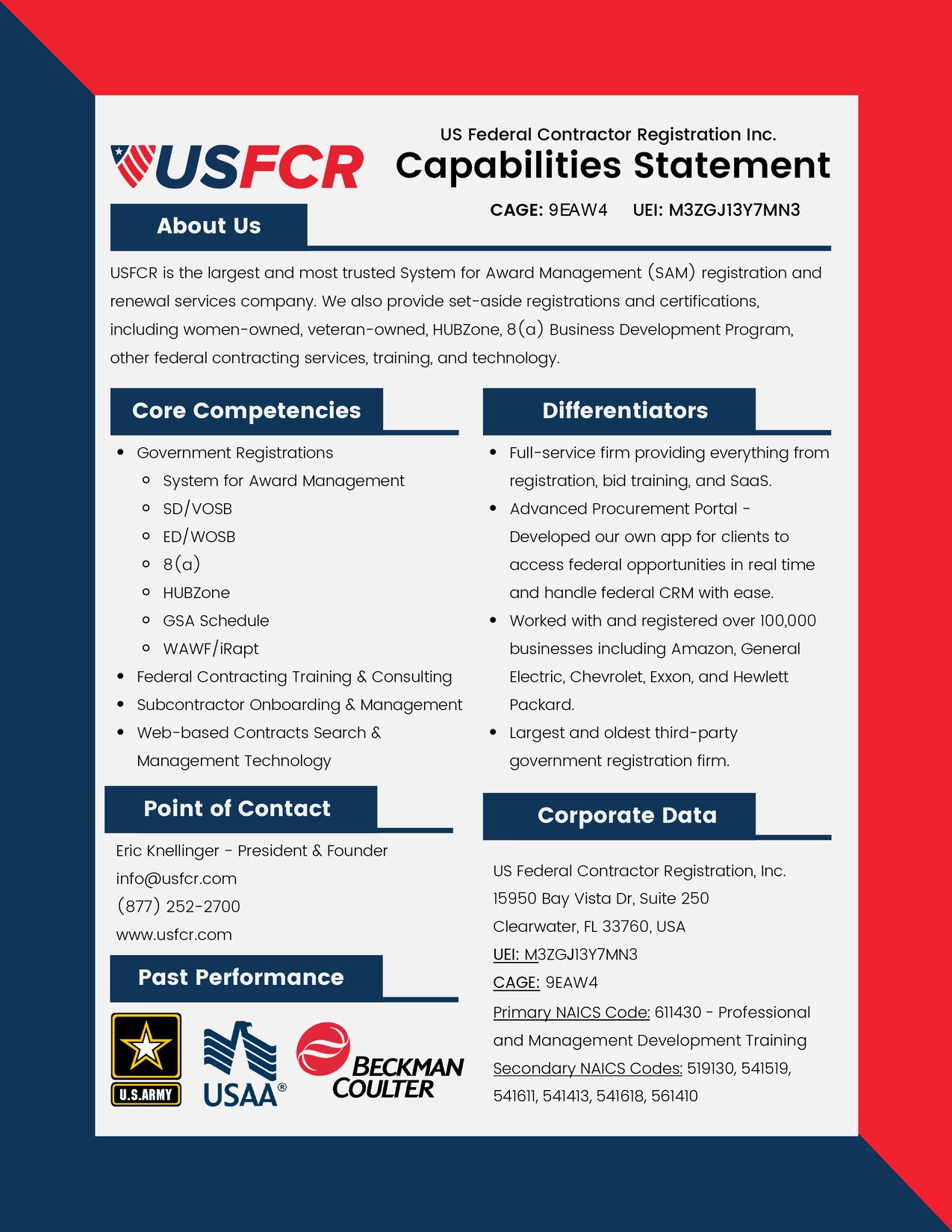
About Us/Company Overview
Before diving into your company’s core competencies, the first thing you’ll want to include in your company capabilities statement is an “About Us” or “Company Overview” section. This should detail your company’s history and an overview of the products and/or services that your company offers.
You may want to include how many years you’ve been in business and a bit about the company’s Owner/CEO. This part is equivalent to an “Objectives Statement” on a personal resume.
It should be short and sweet yet powerful and engaging. Now, we’ll go into more detail on the other main parts.
Core Competencies
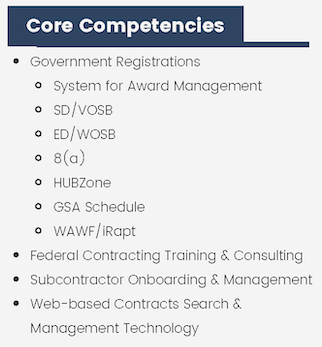
Essentially, the core competencies section is where you can list the services and/or products your company provides as they relate to your customer’s specific needs.
From “Electrical Design” and “Cost Estimating” to “Project Management” and “Systems Analytics,” your core competencies can vary greatly depending on your industry. Be sure to include anything you believe will catch the eye of the client you’re hoping to work with.
The core competencies section of a capabilities statement is typically laid out in bullet form. Some companies also include icons next to each point to illustrate their offerings further. This can be a neat way to add interest to your capabilities statement but don’t overrun your page with graphics. You can keep it both fun and professional at the same time.
While this list of core competencies doesn’t have to be in any specific order, starting with your company’s most specific and specialized services is best. This will surely help you to differentiate your company from the rest.
Don’t get bogged down with including every little thing your company has ever done on this list. That is not the point of the core competencies section. Instead, focus on what your company does best. This should be an overall tailored, agency-specific overview of what your business can uniquely offer.
Past Performance
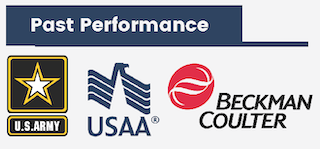
Bids are often awarded by price or a combination of value and past performance.
In this section of your company capabilities statement, you’ll want to identify federal, state, and/or local government contracts and private/commercial contracts of similar scope, size, and complexity.
Any proof of past performance will surely set you apart from your competition.
You should prioritize this list with vendors whom you’ve done similar work for. If your company’s past projects do not relate to the targeted agency’s needs, you can leave them off the list.
However, if you’re a relatively new business/start-up, you may want to list any past projects to show that you have some experience.
Additionally, you may want to include the contact information of the people you’ve worked with on past projects. This way, government buyers and/or prime contractors can easily contact your references and decide more quickly.
Differentiators
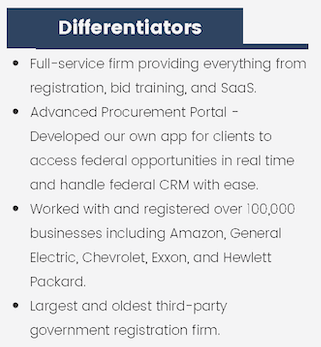
This is one of the most important sections of your government capability statement.
How does your business stand apart from the rest? What makes you different? Why should the government choose YOU?
Securing a contract with the government is no easy task; in fact, it’s highly competitive. Imagine yourself as a government buyer or prime contractor– with so many bids; companies can easily blur together. If you were a buyer or contractor, what would catch your eye?
This section of your capabilities statement should be short and sweet. You’ll want to write a few concise and clear statements that relate to the specific needs of the agency you’re hoping to work with. These short sentences can be bulleted or written as a statement.
Can’t quite think of what to write in this section? Here are some questions that you should be answering:
- How is your company best suited for the needs of this agency?
- What about your product or services sets you apart from the rest?
- How does your product or service offer better solutions than the others available?
Another great tip? Talk to your past clients! Ask them why they chose you over the others and include these reasons in your capabilities statement. Without this section, it’s nearly impossible for a government buyer or prime contractor to make a clear decision.
Surprisingly, many companies fail to include this critical section in their capabilities statement. So, just by highlighting your differentiators, you’ll already be differentiating yourself from the competition!
Corporate Data

This section of your company’s capability statement is straightforward but includes several subsections. You’ll want to have your company’s:
- Location
- Relevant Contact Information
- Codes (UEI, CAGE, NAICS, NIGP, etc.)
Furthermore, be sure to include your company’s website in this section. And, on that note, ensure your website is constantly updated with the latest information. The last thing you want to include is a link to an outdated website that will surely have a government buyer moving you to the bottom of their list.
Corporate data may also include your company’s partners, enterprise architecture, computers, and/or any other technology you can leverage to support your client.
You’ll also want to include a range of financial information about your firm, including your company’s revenue over the last three periods, the number of employees over three periods, and the typical geographic areas you serve. What areas do you cover? What is your forecasted revenue for year-end? Be sure to make it aggressive, post any insurance or license information that you have, and up-to-date contact information.
Insider Tips to Make Your Capabilities Statement Stand Out ABOVE Your Competition
Gathering your content and laying out your capabilities statement is only half the battle. This document should be constantly maintained and updated as your business changes and grows.
Formatting
Once you’ve created your capabilities statement, including all of the above sections, you’ll want to ensure the document is laid out properly and saved in a compatible format for sharing. Capability statements can come in all forms, including HTML/web pages, Word documents, PDFs, and even self-running CDs.
Your capabilities statement is your company’s first impression, so you want to make it stand out. It should be clear that you’ve spent time on this document and that it wasn’t done in a last-minute rush. Typos, grammatical errors, and poor formatting are a sure way to lose out on a government deal.
If you’re printing it to hand out to others, use high-quality, thick/glossy paper. Be sure that the colors used are consistent throughout your company letterhead, website, business cards, etc.
Also, don’t fill up every inch of your capabilities statement with words and graphics– be sure to leave some white space for easy readability.
While it’s good to have a general capability statement, you should also consider creating a new document for each agency, prime, or teaming opportunity. Each capability statement is tailored with the unique information it needs for that particular opportunity.
You should take the time to ensure your capabilities statement is perfect.
Keep up with the Competition
Remember, you’re not the only one in this game. There is plenty of competition out there. The key is constantly monitoring what your competition offers– what would make the government hire them over you? What can you change to give your business an edge over your competitors?
Now is not the time to be lazy or sloppy– you must highlight your business's greatest qualities through your capabilities statement.
Networking is Key
Any business can build an excellent capabilities statement…but even the best of the best can be overlooked or sideswiped by someone who has built better connections throughout the year.
Building relationships with purchasing officers that your competition already works with is essential. You’ll want to ensure that your offer is as good or better than your competitors.
Don’t let a competitor’s success overwhelm or discourage you. Rather, let them motivate you to become bigger and better in terms of performance and success.
Gathering intel from purchasing officers about upcoming contracts and/or vendor awards is possible. Keep building up your base of vendors you work with and look for ways to scratch their backs so they can scratch yours later.
Never forget the power of networking; there is more than one way to skin a cat. Networking is especially useful if you’re a newer company with no past performance experience.
Additionally, whether you win a contract or not, it’s always good to reach out and request a debriefing. This is a great way to glean information for next time, make a good impression, and show that you’re willing to learn as you move forward.
The capabilities statement is pretty much a resume for your company. When giving out your capability statement, you want to make it stand out. Here are some tips:
- Use glossy/thicker paper
- Present a seamless marketing profile — the same colors on all letterhead, business cards, websites, and a capability statement.
- Use graphics
- Be creative
- Tailor your statement for specific uses
Update and Refresh
It’s essential to make sure that your capabilities statement is always fresh and up to date!
Don’t just keep recycling the same capabilities statement year after year. Be sure to always tailor it to the exact job you want and the agency that you are sending it to.
One of the most important areas to keep updated is your company’s contact information. What good is creating a stunning capabilities statement if a government buyer or prime contractor cannot contact you?
Don’t wait until the last minute to update your capabilities statement. This should be an ongoing process throughout the year, so you’re always ready to land the next big contract. Too many details can fall through the cracks– but if you stay on top of it, you’ll surely be ahead of the game when it comes time for the government to award contracts to their chosen vendors.
Don’t Be Afraid to Follow-Up
Be sure to send your company’s capability statements to as many purchasing officers as possible. However, don’t just stop there. Just because you’ve sent it to a prime or purchasing officer once does not mean that he or she has necessarily seen it. These purchasing officers are inundated with marketing materials, and it may take several calls and emails to be seen.
The key is to send it once and then send it until you get a response. There’s a fine line between being persistent and being pushy.
You can always follow up with an email. Remember, the best way to stand out in the federal government is to be authentic and demonstrate reliability and trust.
Maximize Your Federal Contracting Potential with the Simplified Acquisition Program (SAP)
Winning government contracts means more than just registration—it’s about making your business stand out to federal buyers. That’s where the USFCR Simplified Acquisition Program (SAP) comes in.
Online Capabilities Statement (OCS):
An essential tool for marketing your business to contracting officers and prime contractors. Our team creates a customized website designed to meet federal firewall requirements and highlight your core competencies, differentiators, and past performance. This makes your business information easily accessible for buyers.
Full-Service SAM Registration:
We handle every detail of your SAM registration to ensure compliance and reduce your workload, giving you the time to focus on growing your business.
Advanced Procurement Portal (APP):
Gain access to powerful search tools and instant notifications for relevant contract opportunities, keeping your pipeline full and your business ahead of the competition.
What’s Next?
Don't let your business get overlooked by federal buyers. With the Simplified Acquisition Program (SAP) and a professional Online Capabilities Statement (OCS), you’ll be ready to showcase your strengths and secure more contracts.
The next step is simple—explore how an OCS can jumpstart your government contracting strategy. Visit our OCS site to see how they look.
To speak with a Contracting Specialist, Call: (866) 216-5343
Top Articles
The 17 Most Common Types of Government Contracts Explained
Writing a Winning Capabilities Statement in 2025



